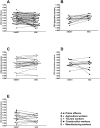High prevalence of hypohydration in occupations with heat stress-Perspectives for performance in combined cognitive and motor tasks
- PMID: 30356308
- PMCID: PMC6200230
- DOI: 10.1371/journal.pone.0205321
High prevalence of hypohydration in occupations with heat stress-Perspectives for performance in combined cognitive and motor tasks
Abstract
Purpose: To evaluate the prevalence of dehydration in occupational settings and contextualize findings to effects on performance in cognitively dominated tasks, simple and complex motor tasks during moderate and high heat stress.
Methods: The study included an occupational part with hydration assessed in five industries across Europe with urine samples collected from 139 workers and analyzed for urine specific gravity. In addition, laboratory experiments included eight male participants completing mild-intensity exercise once with full fluid replacement to maintain euhydration, and once with restricted water intake until the dehydration level corresponded to 2% bodyweight deficit. Following familiarization, euhydration and dehydration sessions were completed on separate days in random order (cross-over design) with assessment of simple motor (target pinch), complex motor (visuo-motor tracking), cognitive (math addition) and combined motor-cognitive (math and pinch) performance at baseline, at 1°C (MOD) and 2°C (HYPER) delta increase in body core temperature.
Results: The field studies revealed that 70% of all workers had urine specific gravity values ≥1.020 corresponding to the urine specific gravity (1.020±0.001) at the end of the laboratory dehydration session. At this hydration level, HYPER was associated with reductions in simple motor task performance by 4±1%, math task by 4±1%, math and pinch by 9±3% and visuo-motor tracking by 16±4% (all P<0.05 compared to baseline), whereas no significant changes were observed when the heat stress was MOD (P>0.05). In the euhydration session, HYPER reduced complex (tracking) motor performance by 10±3% and simple pinch by 3±1% (both P<0.05, compared to baseline), while performance in the two cognitively dominated tasks were unaffected when dehydration was prevented (P>0.05).
Conclusion: Dehydration at levels commonly observed across a range of occupational settings with environmental heat stress aggravates the impact of hyperthermia on performance in tasks relying on combinations of cognitive function and motor response accuracy.
Conflict of interest statement
The authors have declared that no competing interests exist.
Figures






References
-
- Convertino VA, Armstrong LE, Coyle EF, Mack GW, Sawka MN, Senay LC, et al. American College of Sports Medicine position stand. Exercise and fluid replacement. Med Sci Sports Exerc. 28 Available: https://insights.ovid.com/pubmed?pmid=9303999 - PubMed
-
- Sahu S, Sett M, Kjellstrom T. Heat exposure, cardiovascular stress and work productivity in rice harvesters in India: implications for a climate change future. Ind Health. 2013;51: 424–31. - PubMed
Publication types
MeSH terms
LinkOut - more resources
Full Text Sources
Medical

